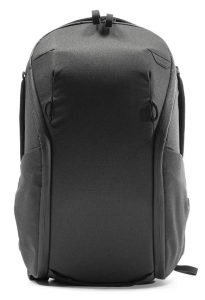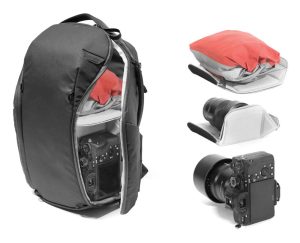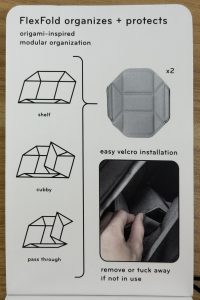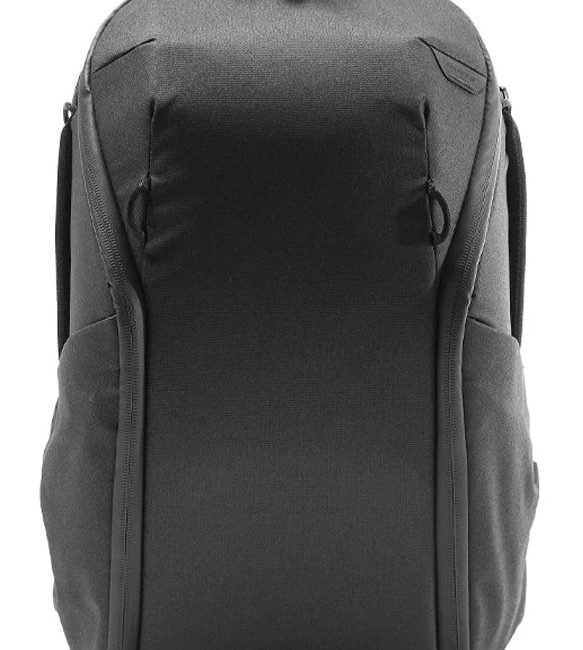There’s a guy I work with who is known in our circles as the one who buys far too many jackets. I think I may soon be known as the one who buys far too many backpacks.
There are two problems to be solved. First, to carry my camera gear, laptop, and more when travelling, and second, to not ruin my back in the process.
Years ago, I bought a Tenba Daypack mini. This has been great for short trips. It comfortably fits my camera with two or three lenses, has extra space for accessories, and also fits my 13” MacBook Pro. It has two downsides — it doesn’t hold much more than that, and second, it doesn’t fit anything larger than a 13” MacBook Pro. Last year I upgraded to a 16” MacBook Pro and there was no way it was fitting in the bag even if I took everything else out.
So before my 2023 trip to Singapore, I bought a Tenba Axis 20L Backpack. This comfortably fit the 16” MacBook Pro, plus the same camera gear, plus a fair amount of extra stuff for travelling. It also nearly ruined my back! If travelling in a way that doesn’t involve a lot of walking, such as a long-distance driving holiday, it’s a good bag. But that precludes overseas travel.
I have two flying holidays planned this year, and so I got to think there has to be a better solution. The first thing I did was downgrade to a 14” MacBook Pro. I could see that only large bags like the Tenba Axis would be able to hold the 16” beast. The smaller laptop also helps my back somewhat. But guess what… it doesn’t quite fit in my old Tenba Daypack.
I began researching for a replacement. I looked for lists on photography sites, but I was also looking for something that didn’t only carry camera gear. My Tenba Daypack is very much a camera bag and is permanently divided into upper and lower sections, as well as the (small) laptop sleeve. My research fairly quickly led me to the Peak Design range.
I’d seen several photographers talking about Peak Design products on various YouTube channels and when I had wanted a stout wrist strap for my camera, it was a Peak Design product I bought. Now, looking at their bag range, I was rather impressed.

They have large and small, backpack and sling and briefcase styles, even a roller bag. They have photography focused bags and more general purpose ones. They have small and large, daily, and travel-focused options.
The model I gravitated to is called the Peak Design Everyday Backpack Zip. It comes in two sizes — a 20 litre and a 15 litre version. They come in black, midnight blue, and ash grey colours and the 15l is also available in bone. I bought the 15l in black.
The name gives away one thing; it’s designed for everyday use, not just as a photographer’s bag. Where my Tenba Daypack weighs a svelte 950g, the Everyday Zip comes in at 1.34 kg with the included internal dividers. However, these can be easily removed to make a basic backpack that is only 1.14 kg.
One of the features is a dedicated laptop sleeve. I paid very close attention to this before purchasing. The marketing on the Peak Design website says, “up to a 13” laptop” and specifically mentions a 13” MacBook Pro. However, it also listed full dimensions for “Max laptop carry” and these informed me that my 14” MacBook Pro would indeed comfortably fit.
Curiously, when the bag arrived, the sheaf of tags that were included state “fits up to 14” laptop”. Of course, I tested my MacBook Pro and it fits nicely. What doesn’t fit is the 14” Lenovo ThinkPad I have for work. I think its issue is primarily the extra 5 mm of thickness. It would probably fit, but not comfortably.
The laptop sleeve is the only truly separate internal compartment in the bag. Like all such bags, the laptop sits against your back. Everyday Zip has a dedicated zip on the top for this section. Inside there is also a separate pouch where you might put a wallet or USB sticks or memory cards. Whatever goes in there does need to be relatively slim.
Next we get to the main compartment. As I mentioned, there is just one, cavernous space that, as the name gives away, amounts to 15 l. You may be wondering why it is called the Everyday Zip. This is the clever part of the bag’s design. It has one zip to access the main compartment, but there are four sliders on it. This takes a little explaining!

If the bag is fully unzipped, the entire top, front, and bottom of the bag folds down. If it’s lying on its back, you have only the two sides, unsupported now, remaining vertical. What makes this clever is the four sliders. You can position them all wherever you want, but the most common arrangement is to have one at the bottom on each side, and a pair in the middle at the top.
If you pull apart the two top sliders, the top of the bag is opened. Zip those back up and instead pull one of the lower sliders all the way along the side. Now you’ve got side access to the bag. Side access is common on camera bags, as cameras and lenses normally live near the bottom while accessories inhabit the top of the bag. This can be a little confusing at first and, if you don’t pay attention, you can end up with all four sliders in the same place! But I think it is such a clever idea that you can essentially open a small top flap, the top half, either side, or the entire bag. It’s your choice.
The zip sliders have sturdy fabric pull loops on them, and these can be unsnapped and threaded through each other to make the zip tamper-resistant.
If there’s just one large space, how do these opening schemes make any sense? The answer is dividers. Two are provided which velcro to both the front and back of the bag. These can be positioned horizontally or vertically. Each forms a simple shelf that is an elongated octagon that conforms to the internal shape of the bag. Used horizontally, this divides the interior into three sections; a top, middle, and bottom.
But there’s more you can do. Each shelf can fold in two ways. You can pop either end of the octagon into the perpendicular. When horizontally mounted, this creates a vertical space down that side. But this folding portion is dual-layered, so you can fold just one layer, and you then end up with no vertical space past the shelf, but a vertical separator on the shelf. It’s difficult to explain without pictures, so the blog post contains just that.

This folding also enables you to have an upper shelf and then have the second one vertical beneath it, creating an upper, left, and right compartments. The Velcro is omnidirectional, so they can bear a load, regardless of what direction you mount them in. Even upside down.
If that was all there is to this bag, it’d be pretty good, but it has more tricks. Each side flap has two pockets inside. An upper one with a simple magnetic catch, and a lower one with a zipper. On the outside are two pockets for drink bottles or the like. These are vented so if your drink spills, it can drain. There is another zippered pocket inside the top flap, and I’ve already mentioned the one in the laptop sleeve.
In addition to the regular backpack straps, there are simple carry handles on the top, left, and right. The backpack straps have pivots at the top to better guide them over your shoulders and are easy to adjust when wearing the bag. There is also a sternum strap that is removable and easy to use, but is not going to come off unless you want it to. There is also an optional waist belt.
There are external carry strap anchors around the bag that enable you to tie loads to the outside of the bag. Inside the two outer pockets there are straps already attached which you can easily pull out and form an X over the front of the pack. This is great for carrying a folded jacket, for instance. You can purchase additional straps to tie loads in other places, including underneath.
In one of the side pockets there is an Anchor Link. This is a snap connector that is used on multiple Peak Design products that is essentially a tether with a connector that snaps together in the middle. This is easy to connect and disconnect but will not do so by itself. It is looped, non-permanently, around the side handle, and they suggest you can attach your keys to this and tuck them away in the pocket. If wearing the backpack when you arrive at your door, you won’t even need to disconnect them as the tether is stretchy. The hand strap I bought for my camera uses the same type of tether.
That’s about it for features, but then there are the credentials. Oh, I suppose the 400D weatherproof nylon outer is a feature, and the 900D bottom surface (so you can place it on a wet surface), but the fact it is 100% made from recycled material is a credential. Oh, and the outer zips are weatherproof, too. The bag is also Fair Trade Certified and 100% carbon-neutral. Durability is built in, but if anything does break, it has a lifetime warranty, if registered after purchase.
The Peak Design Everyday Backpack Zip 15L is available for USD$199.95 or the 20L for $229.95. You can purchase from Peak Design directly, or from many good photographic stores.


I purchased the 20L version in 2019 when I upgraded to the 16 inch MacBook Pro. (It barely fit!) While I’m not a heavy backpack user, it has held up very well. Glad to see someone else liking the zip version instead of the folding top one. While the laptop has been upgraded to the 14” M1 MBP, the backpack will be with me for many years to come.